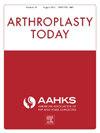利用生成式人工智能分析影像关节置换登记中的种族差异:促进骨科数据公平
IF 1.5
Q3 ORTHOPEDICS
引用次数: 0
摘要
背景医疗数据集中的差异会使偏差长期存在,尤其是在训练深度学习模型时,有可能导致临床应用中出现有偏差的结果。了解这些偏差对于开发公平的医疗保健技术至关重要。本研究利用生成式深度学习技术来探索和理解接受全髋关节置换术的患者中基于种族的放射学差异。方法我们利用大型机构登记册,回顾性地分析了全髋关节置换术患者的骨盆放射照片,这些照片具有人口统计学和图像特征。去噪扩散概率模型生成了以人口统计学和成像特征为条件的X光片。弗雷谢特起始距离评估了生成图像的质量,显示了生成图像的多样性和真实性。在控制患者性别、年龄和体重指数的情况下,生成的 60 个过渡视频显示了白人骨盆向最接近的非裔美国人骨盆的转变,反之亦然。两名外科医生专家和两名放射科医生仔细研究了这些视频,以了解两个种族的放射照片中存在的系统性差异。结果我们的数据集包括 480,407 张骨盆放射照片,其中白人患者多于非裔美国人。生成式去噪扩散概率模型生成了高质量的图像,弗雷谢特起始距离(Fréchet Inception Distance)达到 6.8。专家们确定了区分种族的 6 个特征,包括髋臼间距、骨关节炎程度、闭孔形状、股骨颈轴角、骨盆环形状和股骨皮质厚度。通过将基于种族的差异可视化,该方法有助于识别下游任务中的偏差,从而促进更公平的医疗保健实践的发展。本文章由计算机程序翻译,如有差异,请以英文原文为准。
Analyzing Racial Differences in Imaging Joint Replacement Registries Using Generative Artificial Intelligence: Advancing Orthopaedic Data Equity
Background
Discrepancies in medical data sets can perpetuate bias, especially when training deep learning models, potentially leading to biased outcomes in clinical applications. Understanding these biases is crucial for the development of equitable healthcare technologies. This study employs generative deep learning technology to explore and understand radiographic differences based on race among patients undergoing total hip arthroplasty.
Methods
Utilizing a large institutional registry, we retrospectively analyzed pelvic radiographs from total hip arthroplasty patients, characterized by demographics and image features. Denoising diffusion probabilistic models generated radiographs conditioned on demographic and imaging characteristics. Fréchet Inception Distance assessed the generated image quality, showing the diversity and realism of the generated images. Sixty transition videos were generated that showed transforming White pelvises to their closest African American counterparts and vice versa while controlling for patients’ sex, age, and body mass index. Two expert surgeons and 2 radiologists carefully studied these videos to understand the systematic differences that are present in the 2 races’ radiographs.
Results
Our data set included 480,407 pelvic radiographs, with a predominance of White patients over African Americans. The generative denoising diffusion probabilistic model created high-quality images and reached an Fréchet Inception Distance of 6.8. Experts identified 6 characteristics differentiating races, including interacetabular distance, osteoarthritis degree, obturator foramina shape, femoral neck-shaft angle, pelvic ring shape, and femoral cortical thickness.
Conclusions
This study demonstrates the potential of generative models for understanding disparities in medical imaging data sets. By visualizing race-based differences, this method aids in identifying bias in downstream tasks, fostering the development of fairer healthcare practices.
求助全文
通过发布文献求助,成功后即可免费获取论文全文。
去求助
来源期刊

Arthroplasty Today
Medicine-Surgery
CiteScore
2.90
自引率
0.00%
发文量
258
审稿时长
40 weeks
期刊介绍:
Arthroplasty Today is a companion journal to the Journal of Arthroplasty. The journal Arthroplasty Today brings together the clinical and scientific foundations for joint replacement of the hip and knee in an open-access, online format. Arthroplasty Today solicits manuscripts of the highest quality from all areas of scientific endeavor that relate to joint replacement or the treatment of its complications, including those dealing with patient outcomes, economic and policy issues, prosthetic design, biomechanics, biomaterials, and biologic response to arthroplasty. The journal focuses on case reports. It is the purpose of Arthroplasty Today to present material to practicing orthopaedic surgeons that will keep them abreast of developments in the field, prove useful in the care of patients, and aid in understanding the scientific foundation of this subspecialty area of joint replacement. The international members of the Editorial Board provide a worldwide perspective for the journal''s area of interest. Their participation ensures that each issue of Arthroplasty Today provides the reader with timely, peer-reviewed articles of the highest quality.
 求助内容:
求助内容: 应助结果提醒方式:
应助结果提醒方式:


